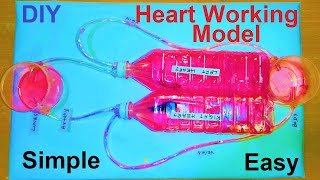A heart working model using two plastic bottles demonstrates the process of blood circulation in the human heart, including the movement of oxygenated and deoxygenated blood between the heart, lungs, and the body.
The two bottles represent the two sides of the heart: one for the right side (pumping deoxygenated blood to the lungs) and the other for the left side (pumping oxygenated blood to the body).

Key Components of the Model:
- Two Plastic Bottles: Each bottle represents one of the heart’s chambers. The right bottle simulates the right atrium and right ventricle, while the left bottle represents the left atrium and left ventricle.
- Flexible Tubing: Tubes are used to connect the bottles, mimicking blood vessels that carry blood from the heart to the lungs and body.
- Balloon: Balloons are attached to the openings of the bottles to act as the heart’s valves and simulate the heart’s contraction (systole) and relaxation (diastole).
- Colored Water: Red-colored water represents oxygenated blood, and blue-colored water represents deoxygenated blood.
- Valve Mechanism: Small one-way valves (made from rubber or plastic) are added to the tubes to demonstrate the action of heart valves that prevent blood from flowing backward.
How It Works(heart working model):
- Set Up the Bottles: Connect the two bottles with flexible tubing. The right bottle should be connected to a tube that leads to another bottle or container, representing the lungs, where deoxygenated blood is oxygenated.
- Simulate Pumping: Attach a balloon to each bottle. When you inflate and deflate the balloons, you mimic the heart’s pumping action. Inflation represents the contraction of the heart, forcing blood out of the chambers.
- Blood Flow: As the right bottle (right heart) pumps blue-colored water to the lungs, the left bottle (left heart) pumps red-colored water to the body. The tubes simulate arteries and veins, carrying oxygenated and deoxygenated blood.
- Valve Action: The valves in the tubing prevent the backflow of liquid, showing how heart valves ensure blood moves in the correct direction.
Applications and Learning:
- Real-Life Insight: This model demonstrates the process of heart pumping and blood circulation in the body.
- Educational Value: It helps explain heart function, circulation, and the importance of valves in maintaining proper blood flow.
This working model is a hands-on way to understand the basic mechanics of the heart and circulatory system, making it perfect for educational projects and science fairs.

